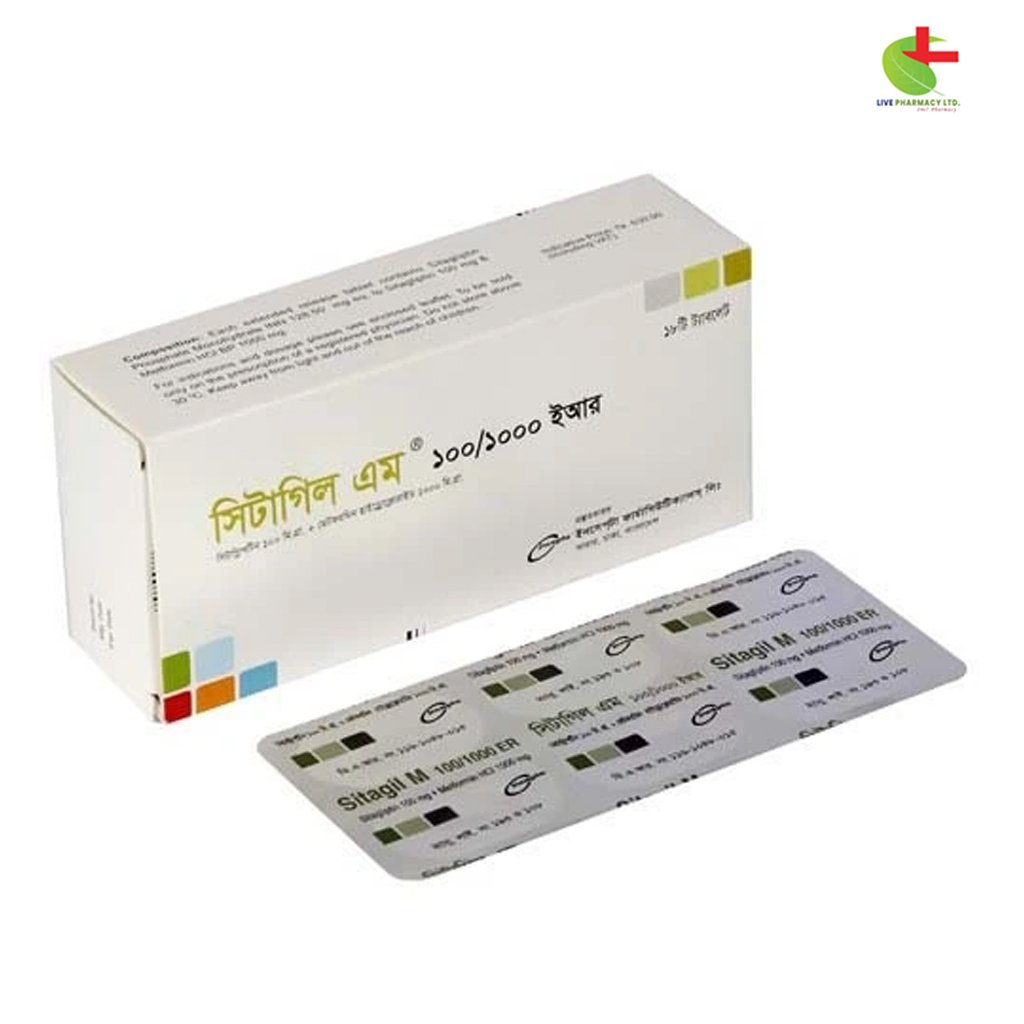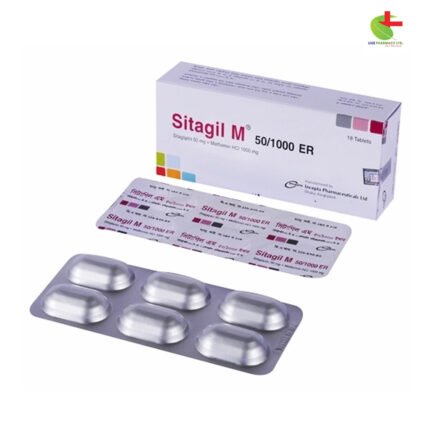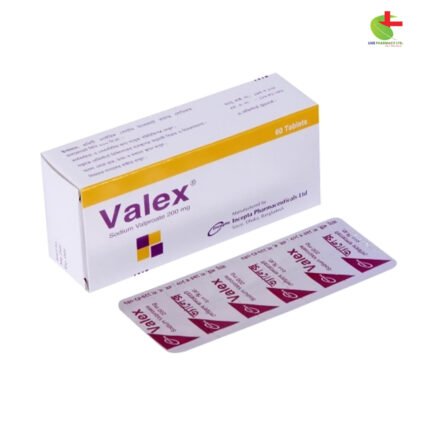Sitagil M 100/1000 ER
210.00৳ Strip
- Sitagliptin and Metformin combination tablet for managing blood sugar in adults with type 2 diabetes.
- Enhances insulin release and reduces glucose production to improve glycemic control.
- Best used alongside diet and exercise for optimal results.
- Dosage tailored to individual needs, to be taken under healthcare professional guidance.
 Brand
Brand
|
Incepta Pharmaceuticals Ltd |
|---|---|
 Generics
Generics
|
Sitagliptin + Metformin Hydrochloride |
 Type
Type
|
Tablet |
Indications
This medication is prescribed as an adjunct to diet and exercise to help manage blood sugar levels in adults with type 2 diabetes mellitus. It is used when treatment with both sitagliptin and metformin is appropriate.
Important Limitations of Use:
- Not suitable for type 1 diabetes or diabetic ketoacidosis, as it would not be effective for these conditions.
- Unstudied in patients with a history of pancreatitis—it is unknown if those with a pancreatitis history face a higher risk of developing pancreatitis while using this medication.
Always use this medication as advised by a registered healthcare provider.
Pharmacology
This combination tablet features two powerful antihyperglycemic agents that work synergistically to improve glycemic control in people with type 2 diabetes.
- Sitagliptin is a DPP-4 inhibitor that helps increase incretin hormone levels, such as GLP-1 and GIP, which are crucial for regulating blood sugar. By inhibiting DPP-4, sitagliptin helps prolong the action of these hormones, boosting insulin release and reducing glucose production by the liver.
- Metformin HCl, a biguanide, works through a different mechanism, reducing hepatic glucose production, decreasing glucose absorption in the intestines, and enhancing the body’s ability to utilize glucose in tissues.
Together, these two components work to regulate blood sugar in a glucose-dependent manner, making this combination a highly effective treatment for managing type 2 diabetes.
Dosage & Administration
The dosage of this combination tablet should be tailored to the patient’s current regimen, effectiveness, and tolerability. Do not exceed the maximum daily dose of 100 mg sitagliptin and 2000 mg metformin.
- Starting dose for patients not on metformin: 50 mg sitagliptin / 500 mg metformin twice daily, with gradual dose escalation to minimize gastrointestinal side effects.
- Starting dose for patients already on metformin: Adjust sitagliptin to 50 mg twice daily (100 mg total daily dose) while keeping the existing dose of metformin. For those taking 850 mg metformin twice daily, the recommended starting dose is 50 mg sitagliptin / 1000 mg metformin twice daily.
This tablet is typically taken twice daily with meals. If switching to extended-release tablets, the same total dose should be maintained.
Interactions
- Cationic Drugs: Use with caution when combined with drugs eliminated by renal tubular secretion.
- Phenprocoumon: Metformin may reduce the anticoagulant effect. Regular INR monitoring is recommended.
- Levothyroxine: This thyroid medication can reduce metformin’s hypoglycemic effects. Close monitoring of blood glucose levels is advised, especially when starting or discontinuing thyroid hormone therapy.
Contraindications
This tablet should not be used in patients with:
- Renal disease or dysfunction, as indicated by abnormal creatinine clearance or elevated serum creatinine levels (≥1.5 mg/dL for males, ≥1.4 mg/dL for females).
- Metabolic acidosis, including diabetic ketoacidosis.
- History of serious hypersensitivity reactions, such as anaphylaxis or angioedema to this medication or its components.
It is also recommended to temporarily discontinue this medication before radiologic studies using iodinated contrast agents, as they may cause sudden changes in renal function.
Side Effects
Common side effects in patients starting combination therapy with sitagliptin and metformin include:
- Diarrhea, upper respiratory tract infections, and headaches.
Other side effects include:
- Hypoglycemia in patients using this combination with sulfonylurea or insulin.
- Nasopharyngitis (common with sitagliptin monotherapy).
Gastrointestinal issues such as diarrhea, nausea, vomiting, and abdominal discomfort are more common during metformin initiation.
Pregnancy & Lactation
- Pregnancy Category B: While there are no sufficient studies on the safety of this combination during pregnancy, it should only be used if clearly needed.
- Lactation: It’s unknown if sitagliptin is excreted in human milk, so use with caution while breastfeeding.
Precautions & Warnings
- Lactic Acidosis: A rare but serious side effect due to metformin accumulation, especially in patients with renal impairment, dehydration, or sepsis. Symptoms include muscle pain, difficulty breathing, and severe fatigue. If suspected, discontinue this medication immediately and seek urgent medical attention.
- Renal Function: Regularly monitor kidney function, as there have been reports of acute renal failure.
- Pancreatitis: Reports of acute pancreatitis have been associated with sitagliptin. If symptoms develop, discontinue use and seek medical evaluation.
- Vitamin B12 Deficiency: Long-term metformin use can reduce B12 levels, potentially leading to peripheral neuropathy. Regular monitoring is recommended.
Additional precautions:
- Avoid excessive alcohol consumption.
- Monitor thyroid function in patients with hypothyroidism.
- Discontinue temporarily during periods of stress, such as infection or surgery.
Overdose Effects
- Sitagliptin Overdose: Supportive treatment is recommended, and the drug is modestly dialyzable, which may be helpful in cases of overdose.
- Metformin Overdose: Ingesting high doses of metformin (over 50 grams) can be dangerous. Hemodialysis may be needed to remove excess drug from the system, as metformin is dialyzable.
Therapeutic Class
Combination oral hypoglycemic preparations.
Storage Conditions
Store below 25°C in a dry place, away from light. Keep out of reach of children. Do not use after the expiry date. This medication is to be dispensed only upon the prescription of a registered physician.













Reviews
There are no reviews yet.